The betta or Siamese fighter is a colorful freshwater fish that is commonly described as the jewel of aquariums. They make fascinating pets with their small size, impressive colors, and aggressive temperaments.
Bettas are relatively hardy fish that thrive in various tank setups, provided that the water conditions are suitable. Aside from a heater and filter, live plants can be a wonderful addition to their aquarium. Bettas naturally inhabit bodies of water that contain dense vegetation which benefit them in many ways.
With so many different aquarium plants available, it can be difficult to find the right ones to grow for your betta fish. Well, this article aims to help narrow down your options by discussing your most popular options.

Benefits of Aquarium Plants for Betta Fish
There are more to live aquarium plants than what meets the eye. Live plants have endless benefits for betta fish, but the following are the most noteworthy.
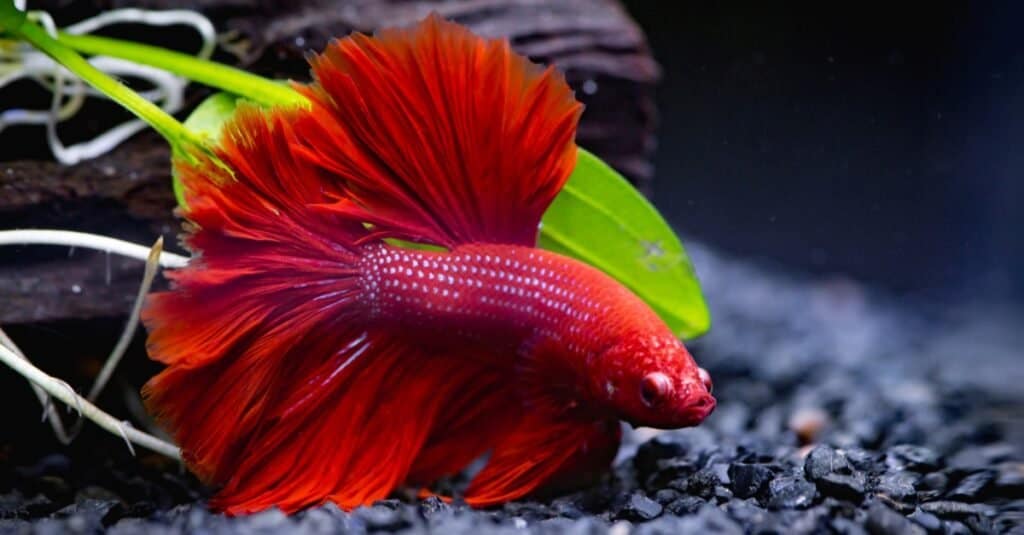
Betta fish enjoy hiding amongst live plants since this is what they do in the wild.
©ANURAK PONGPATIMET/Shutterstock.com
- Creates a naturalistic environment for betta fish to explore.
- Helps reduce stress by making your betta fish feel more secure and sheltered.
- Naturally filters the water by using waste products like nitrates and fish poop for growth.
- Oxygenates the water by releasing oxygen (O2) and absorbing carbon dioxide (CO2).
- Encourages the growth of beneficial bacteria and biofilm.
The Best Plants for Betta Fish
You cannot just grow any aquatic plant in your betta fish’s aquarium. Some plants are unsuitable because they do not thrive in the same water conditions as bettas. Whereas other plants might be better for brackish or saltwater aquariums, and others are too difficult for the average fish keeper to grow.
The best plants for betta fish are slow to moderate-growing freshwater plants that can grow in tropical conditions – 75° to 83° Fahrenheit. You ideally want to choose hardy plants that have undemanding lighting and fertilizer requirements. Those types of plants will be the easiest to care for, especially if you are new to aquarium plant care.
Let’s take a look at the top 12 best plants for betta fish.
1. Hornwort
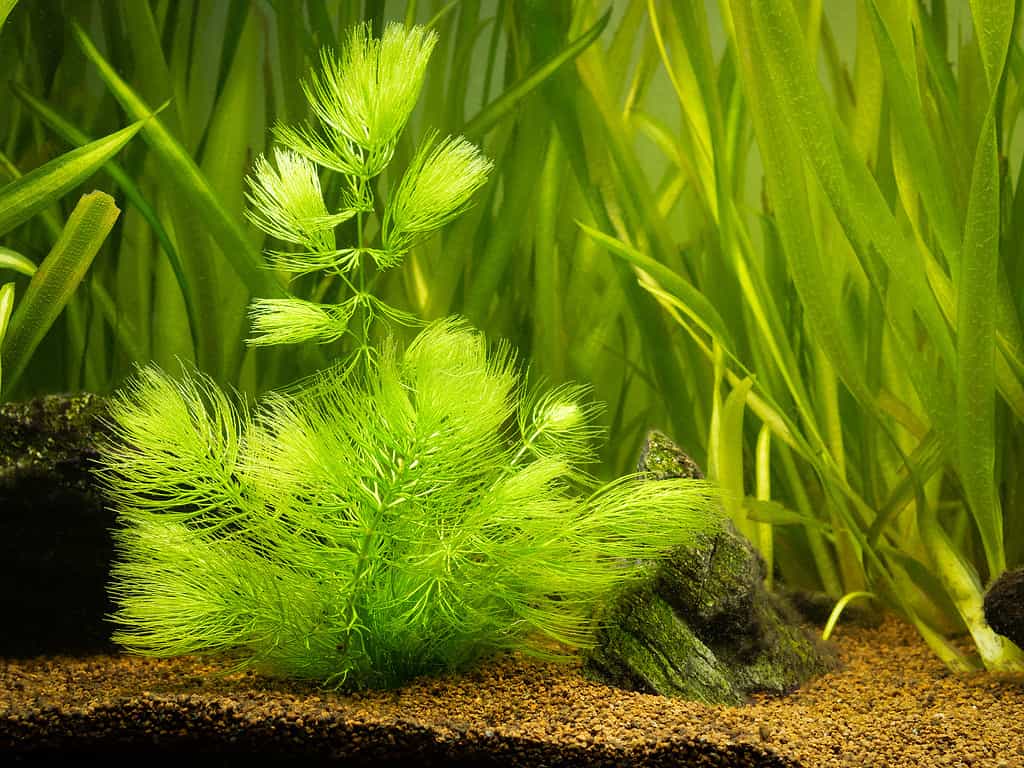
The hornwort plant is a versatile aquarium plant that grows floating or in a substrate.
©Juan Carlos Juarez Jaramillo/iStock via Getty Images
| Scientific name: | Ceratophyllum demersum |
| Size: | 10 feet long |
| Temperature: | 50° to 85° Fahrenheit |
The first plant on our list is the incredibly hardy and adaptable hornwort, a tropical freshwater plant commonly found in marshes and lakes. This aquatic plant is recognized by its bright green foliage that looks similar to pine needles. Hornwort is a beginner-friendly plant that is easy to care for, so you don’t need a green thumb to grow it.
You don’t need to use a substrate with hornwort, nor do you need to worry about its placement. Hornwort can either be grown planted or left floating, as long as the plant is fully submerged in water.
Furthermore, hornwort can tolerate a wide range of temperatures, including the tropical conditions that betta fish live in. This plant will grow well in moderately bright conditions and does not require any special fertilizers or CO2.
2. Amazon Sword
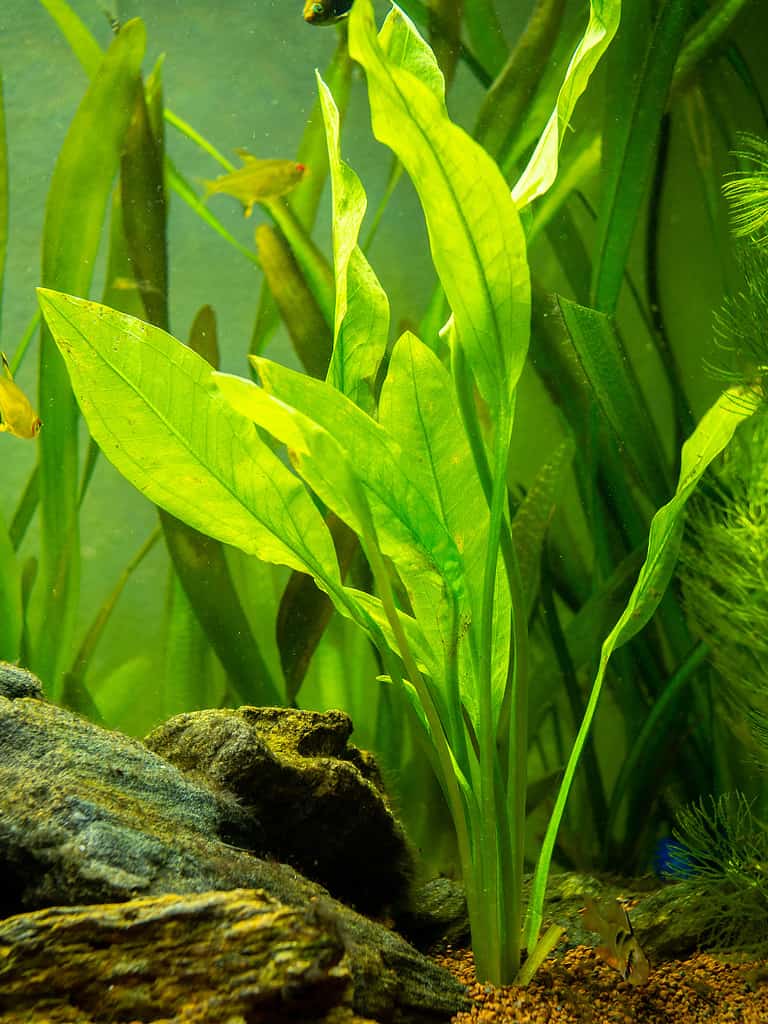
The Amazon sword is one of the most popular aquarium plants in the world.
©Juan Carlos Juarez Jaramillo/iStock via Getty Images
| Scientific name: | Echinodorus amazonicus |
| Size: | 12 to 20 inches |
| Temperature: | 70° to 82° Fahrenheit |
Amazon sword is a popular tropical plant that is relatively easy to care for. The plant has distinctive green leaves that branch out and resemble a mini sword. Amazon sword grows to around 12 inches tall in aquariums, but larger in the wild. However, Amazon swords have a slow growth rate of only 1 inch per month. This plant’s large leaves offer bettas a place to rest when they are feeling tired, especially the heavy fin varieties.
You can grow an Amazon sword at the same temperature you keep your betta fish in. Amazon sword does not grow well in cold water conditions, which will significantly slow down its growth. While fertilizers and additional CO2 are an option when growing Amazon swords, it is beneficial.
Amazon swords need to be planted in the sandy substrate so that they can establish a proper root system. This plant will not grow if it is left floating in the water and will likely die off. You don’t need to go overboard with lighting for an Amazon sword, as moderate lighting is sufficient.
3. Java Moss

Java moss is very easy to care for, which is why it is recommended for beginner aquarists.
©Swapan Photography/Shutterstock.com
| Scientific name: | Taxiphyllum barbieri |
| Size: | Very large |
| Temperature: | 68° to 90° Fahrenheit |
One of the easiest plants to grow for betta fish is java moss. This mossy plant naturally grows along rocks and riverbanks in moist tropical conditions. Java moss has a rapid growth rate, although it usually doesn’t grow larger than the size of an aquarium. It has multiple uses in aquariums, although it is primarily used for aquascaping and ornamental purposes. You can attach java moss to driftwood or rocks in your aquarium, but you can also leave it floating.
Java moss has no definite size since it produces multiple green leaves and rhizoids. This plant will continue to grow with no sign of stopping when the conditions are ideal. Java moss requires moderately bright overhead lighting and warm water temperatures above 68 degrees Fahrenheit. Its growth is accelerated in warm water and bright lighting for more than 8 hours per day.
4. Water Sprite
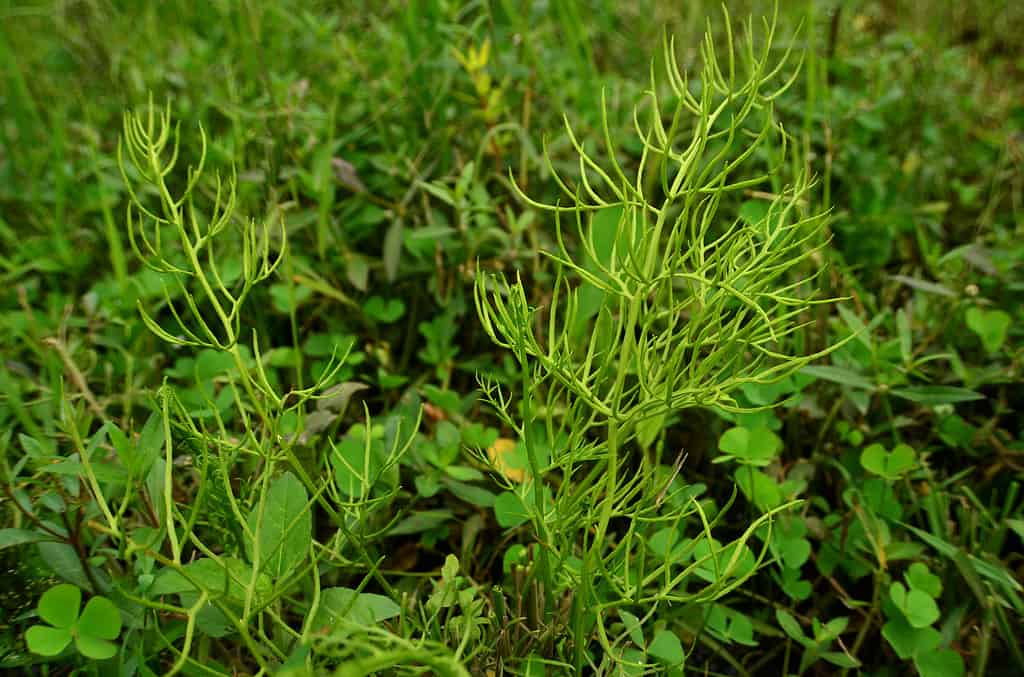
This plant is also known as water sprite, Indian fern, water fern, oriental waterfern, and water hornfern.
©wahid hasyim asyari/iStock via Getty Images
| Scientific name: | Ceratopteris thalictroides |
| Size: | 10 to 15 inches |
| Temperature: | 70° to 82° Fahrenheit |
Water sprite is an adaptable freshwater plant that is easy to grow in betta fish aquariums. It goes by other names such as Indian fern or water fern, but water sprite is commonly used. Water sprite has a moderate growth rate which can be sped up with fertilizers, bright lighting, and regular maintenance. However, water sprite can grow just fine without them. The leaves of water sprite are a vibrant green color and form from the plant’s soft stems.
Like with java moss or hornwort, water sprite does not need to be planted on a substrate. You can leave the plant floating in the water without interfering with its growth. Otherwise, you grow it as a background runner on a sandy substrate.
5. Anubias
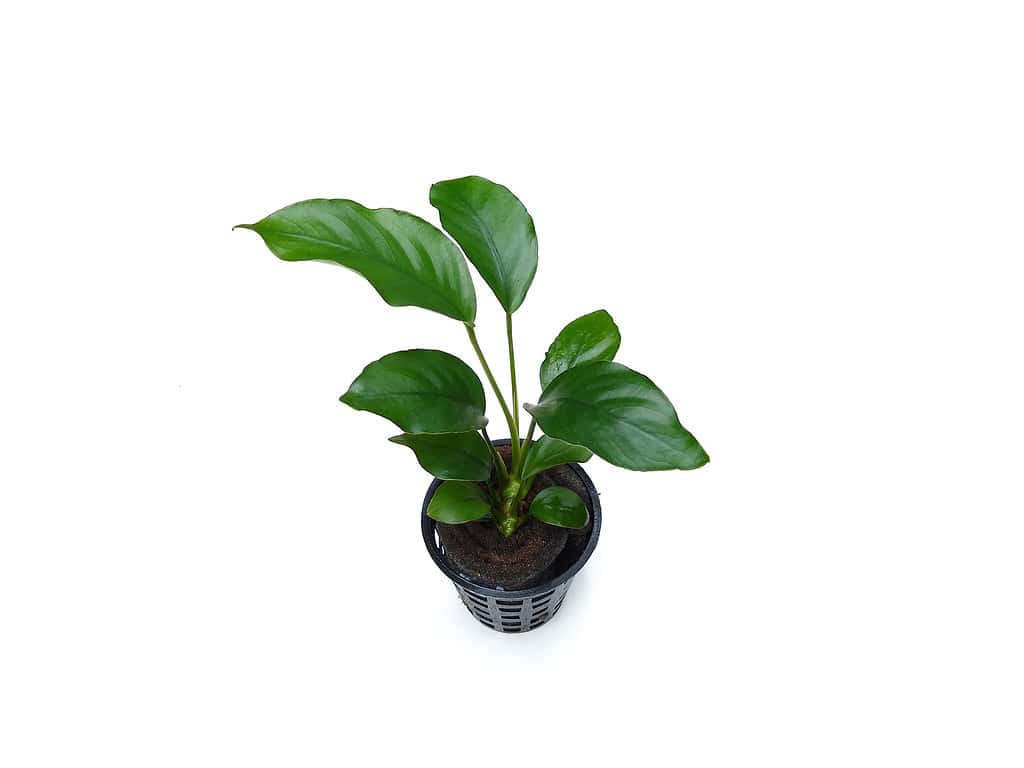
Anubias is a hardy aquarium plant that has broad leaves betta fish can rest on.
©sisyphuszirix/iStock via Getty Images
| Scientific name: | Anubias afzelii |
| Size: | 10 to 24 inches |
| Temperature: | 70° to 82° Fahrenheit |
Anubias is a low-maintenance aquarium plant that looks striking in betta fish aquariums. This plant is versatile and grows in substrates or attached to rocks or driftwood. However, the plant’s rhizome should not be covered to prevent it from rotting. Anubias start out small but can grow up to 24 inches tall in favorable conditions. In a betta fish aquarium, the plant is likely only going to reach a height of 6 to 10 inches. The broad leaves are a dark green coloration and grow from thin stems connected to a main root system. Anubias does not require any specialized care, but fertilizers can aid in its growth.
6. Vallisneria

There are several different types of
Vallisneriaplants with long grass-like leaves.
©stoickt/iStock via Getty Images
| Scientific name: | Vallisneria americana natans |
| Size: | 20 to 40 inches |
| Temperature: | 68° to 86° Fahrenheit |
Vallisneria, also known as eelgrass or tape grass is a genus of freshwater plant. There are different types of Vallisneria, but the V. Americana natans is recommended for betta fish aquariums. Vallisneria has long tendril-like green leaves that look like blades of grass. It needs to be planted in a fine gravel or sandy substrate rather than standard-sized gravel. The leaves grow upwards to the light and provide bettas with places to hide and explore. Vallisneria can be grown as a foreground or background plant and looks best when grown alongside other aquarium plants.
Caring for Vallisneria is relatively simple as the plant does not require any fertilizers or CO2. However, Vallisneria needs a moderate to bright overhead light for proper growth. This plant thrives in tropical conditions and does better at higher temperatures with few fluctuations.
7. Amazon Frogbit
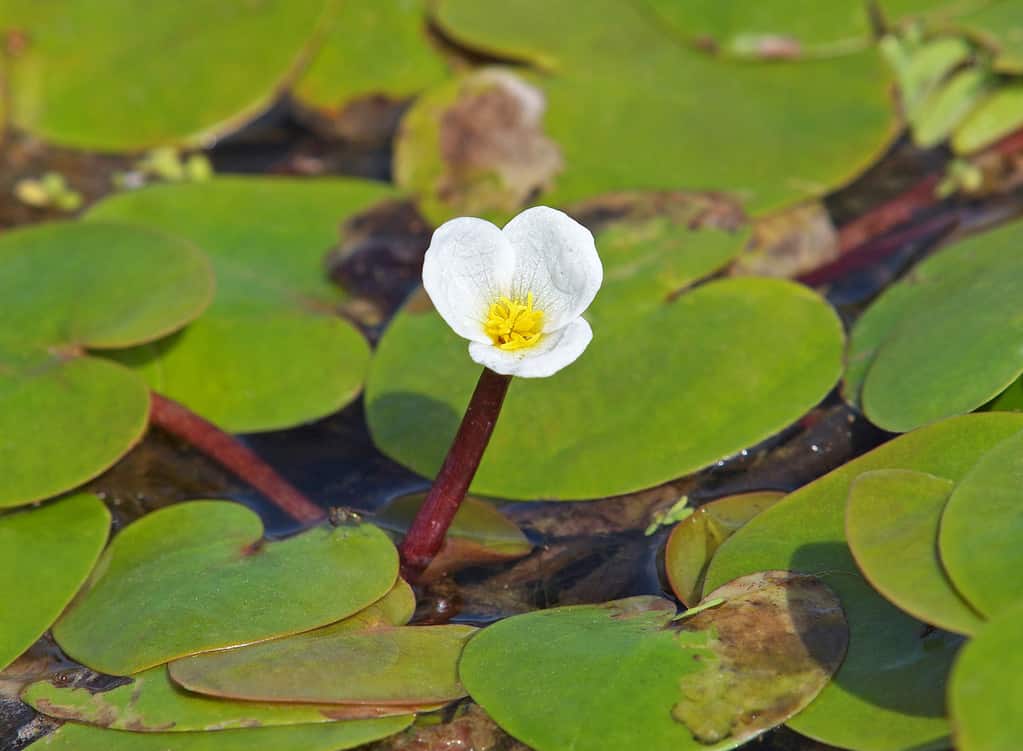
Amazon frogbit floats at the top of water and is known for its excellent water filtering abilities.
©Emilio100/Shutterstock.com
| Scientific name: | Limnobium laevigatum |
| Size: | 20 inches |
| Temperature: | 68° to 86° Fahrenheit |
Amazon frogbit is a floating plant that has multiple uses in betta fish aquariums. You can grow this plant to cover the top of an aquarium if you do not use a lid or grow it for its water purification benefits. Amazon frogbit develops a long root system in the water that actively absorbs nitrates while giving bettas a place to hide.
Furthermore, the Amazon frogbit does not need to be planted in a substrate and thrives without fertilizers and moderately bright lighting. The Amazon frogbits green leaves grow out of the aquarium and reach 1.5 to 3 inches in diameter. This plant has a rapid growth rate and can quickly overrun an aquarium, but it is easy to keep under control. The plants can be removed from the aquarium when necessary without disturbing the other pieces of Amazon frogbit.
Keep in mind that the Amazon frogbit is an invasive species and will need to be disposed of appropriately.
8. Java Fern
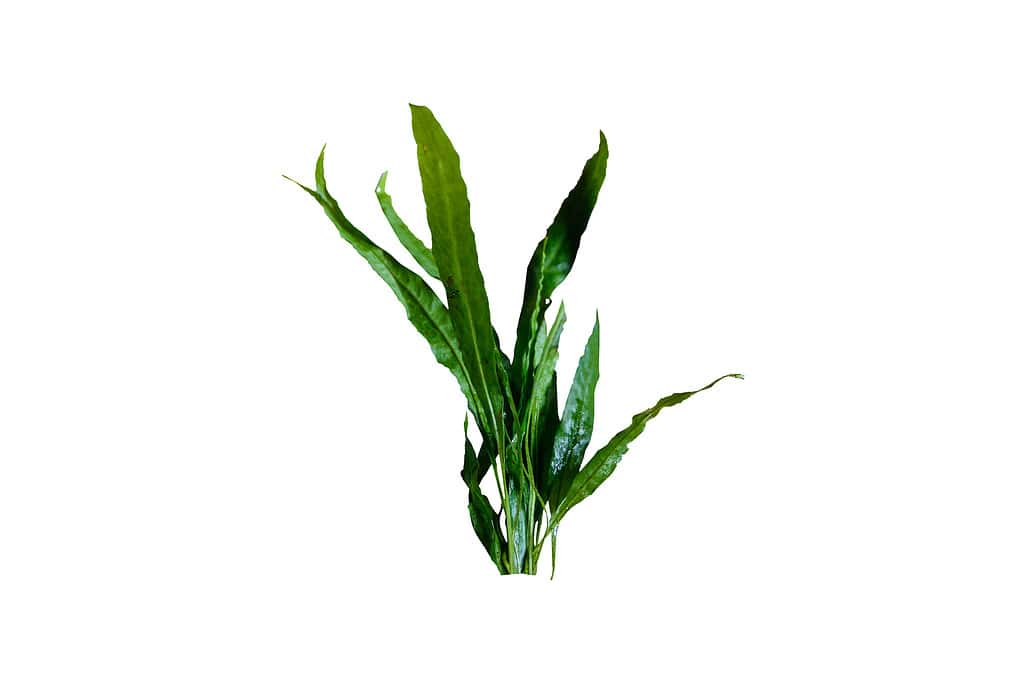
Many beginner aquarists can easily grow java fern in their bettas aquarium.
©Imam Tri Hidayat/iStock via Getty Images
| Scientific name: | Microsorum Pteropus |
| Size: | 8 to 15 inches |
| Temperature: | 60° to 85° Fahrenheit |
Java fern is a hardy freshwater plant with long green leaves and brownish stalks connected to a rhizome. This plant is hardy, adaptable, and really easy to grow. Java moss can grow up to 15 inches tall and 8 inches wide but has a slow growth rate. The dense leaves are the perfect hiding or resting spots for betta fish.
Although java fern is a hardy plant, it does need good water quality to thrive. Java fern leaves easily turn brown or dark purple when the plant is not receiving proper nutrients, lighting, or aeration in the aquarium. Java fern should ideally grow in betta fish aquariums with moderately bright lighting and sufficient aeration to prevent the water from becoming stagnant. The preferred temperature range for java fern is similar to bettas at 75 to 82 degrees Fahrenheit. Growing java fern in cold water temperatures can slow down their growth.
9. Water Wisteria
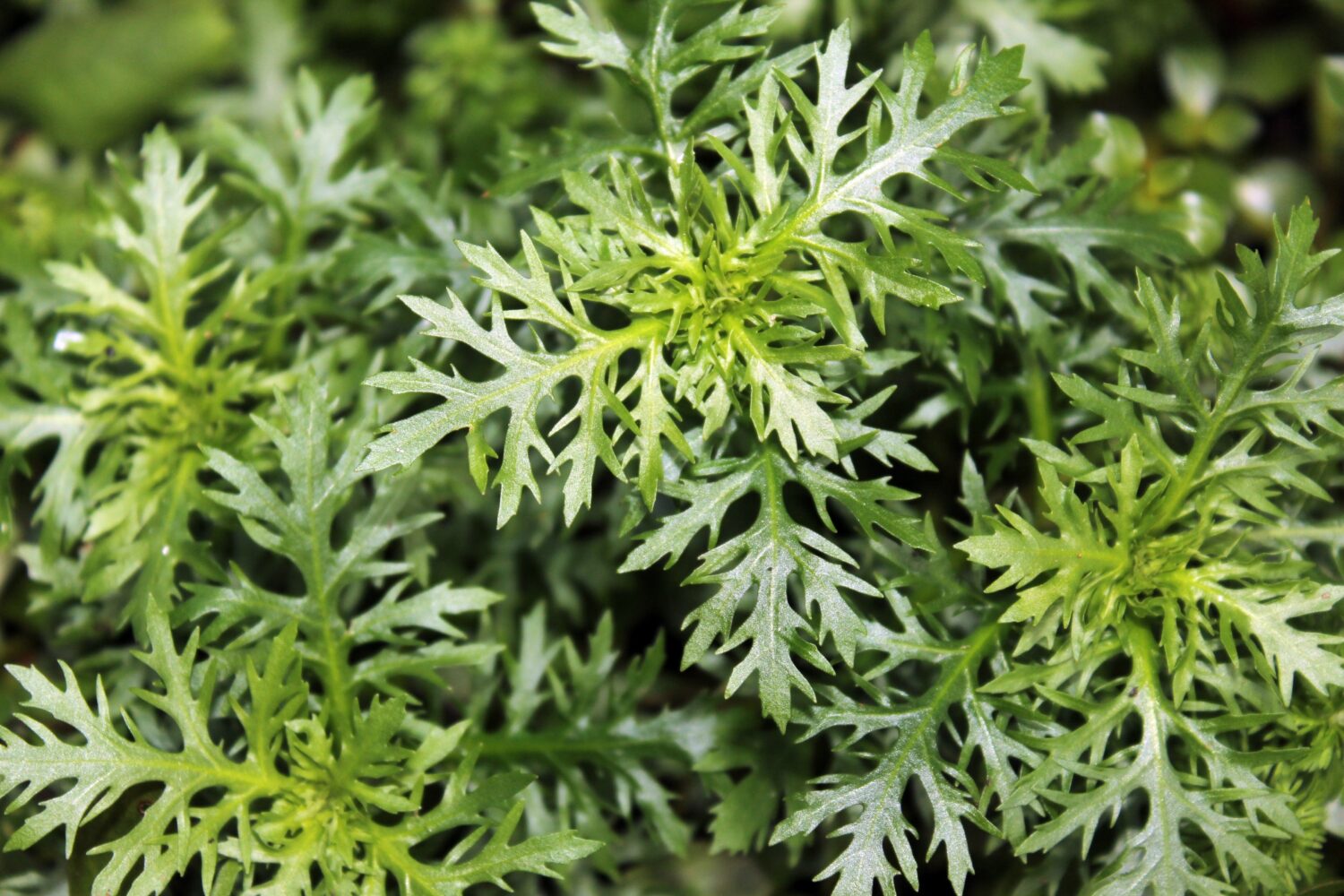
One of the easiest plants to grow in betta fish aquariums in water wisteria.
©Jarot Sarwosambodo/Shutterstock.com
| Scientific name: | Hydrophila difformis |
| Size: | 12 to 20 inches |
| Temperature: | 74° to 82° Fahrenheit |
Water wisteria is a popular aquarium plant sometimes confused for water sprite. However, water wisteria produces flowers above the surface and has a wirier leaf structure. Both plants are equally bushy and have similar benefits in betta fish aquariums. These benefits include shelter, water purification, and increased oxygenation. Water wisteria has a rapid growth rate in ideal conditions and can grow up to 20 inches if the tank size allows it.
You do not need to use any special fertilizers to keep water wisteria lush and healthy. This plant readily absorbs nitrates and waste products to use for its growth and doesn’t need additional CO2. Most beginner betta fish keepers can easily grow water wisteria in an aquarium without having to do much maintenance.
10. Ludwigia Super Red Mini

The dark reddish-purple leaves of
Ludwigialook spectacular amongst other green foliage.
©ComR78/iStock via Getty Images
| Scientific name: | Ludwigia palustris |
| Size: | 8 to 10 inches |
| Temperature: | 64° to 82° Fahrenheit |
The vibrant mini super red Ludwigia plant is a must-have if you want to liven up your betta’s aquarium. Ludwigia super red mini is a small bushy aquatic plant that has a mixture of green and red leaves. The intensity of the leaves’ red coloration can darken under bright lighting. The leaves are small and delicate and grow from the plant’s dark red stems.
Ludwigia super red mini plants stand out in aquariums when grown with other green plants. The plant’s redness looks particularly striking against black or white substrates and backgrounds. Ludwigia super red mini plants need to be buried in a substrate. The plant should receive around 8 to 10 hours of moderate to bright overhead lighting for proper growth. Aquatic plant fertilizers can aid in the Ludwigia super red mini plants’ growth and should be dosed every 2 to 4 weeks.
11. Dwarf Hairgrass
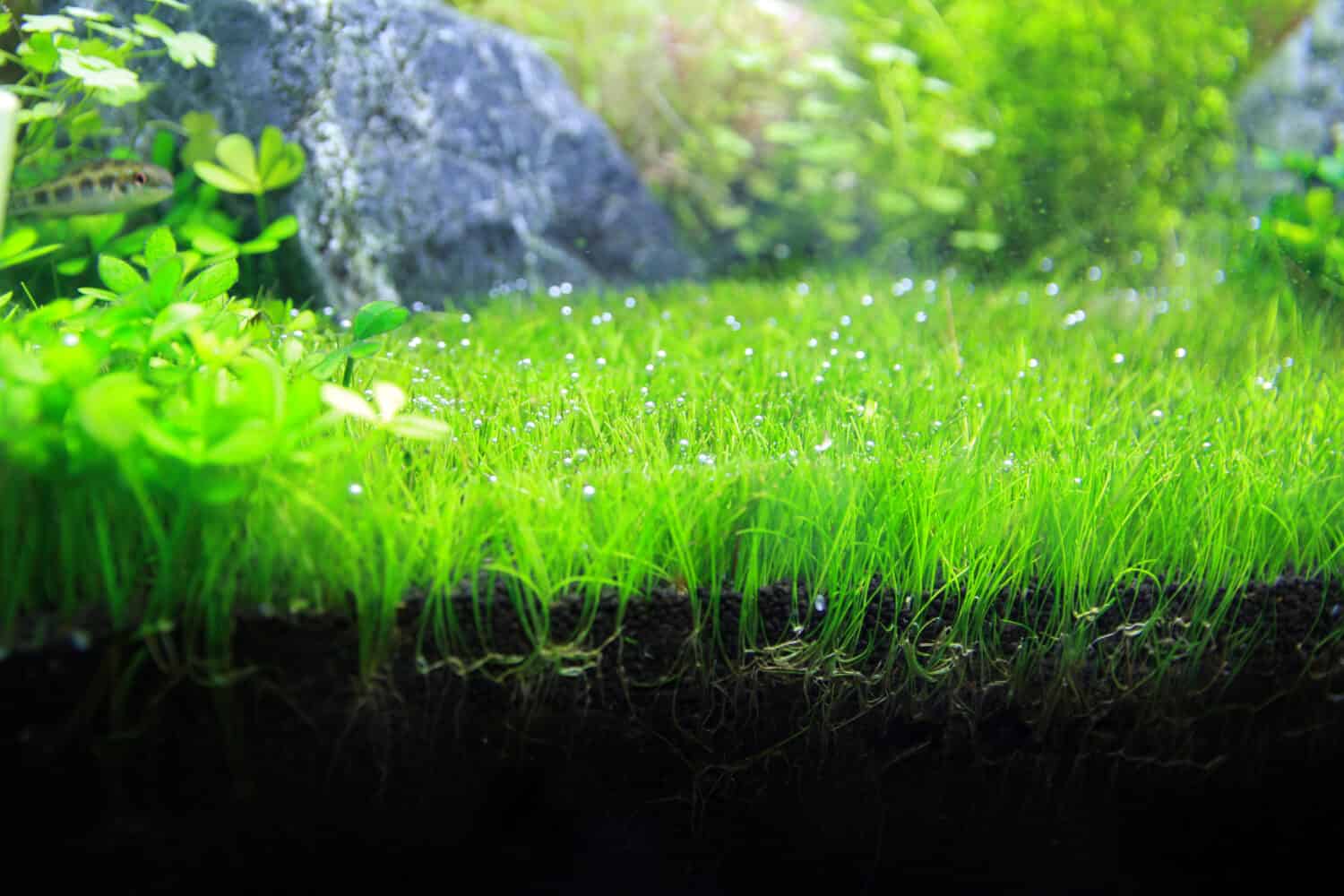
Dwarf hairgrass looks like aquatic grass and has numerous benefits in betta fish aquariums.
©muaiyayo/Shutterstock.com
| Scientific name: | Eleocharis sp. |
| Size: | 4 to 6 inches |
| Temperature: | 50° to 83° Fahrenheit |
There are two species of dwarf hairgrass that can be grown for betta fish – E. acicularis and E. parvula. Dwarf hairgrass is a small yet fast-growing carpeting plant that has bright green leaves. You can recognize dwarf hairgrass by the plants’ grassy leaves that usually grow no taller than 6 inches. Dwarf hairgrass is suitable for beginners, although this plant is higher maintenance than the other ones on our list.
You can purchase dwarf hairgrass in mat forms if you do not want to go the route of planting each clumps yourself. Dwarf hairgrass can grow in most sandy or fine quartz substrates. However, the vibrant green leaves look best with dark brown or black substrates. Dwarf hairgrass requires moderate to bright overhead lighting, and benefits from weekly fertilizers and CO2 injections.
Although dwarf hairgrass doesn’t offer clusters of leaves for betters to rest on, they do create a natural environment and help immensely with water quality.
12. Pennywort

Pennywort has unusual leaves that look like umbrellas. They offer bettas a comfortable place to rest.
©liuyushan/iStock via Getty Images
| Scientific name: | Hydrocotyle leucocephala |
| Size: | 16 to 24 inches |
| Temperature: | 68° to 82° Fahrenheit |
Pennywort is an unusual-looking aquatic plant with flat rounded leaves and brownish-green stems. This plant is usually called Brazilian pennywort or water ivy and is native to South America. Pennywort can grow up to 24 inches tall in the wild, but commonly around 16 inches in aquariums. The unique leaves are the perfect place for bettas to rest on. The leaves are upturned and supported by long stems that branch towards the side and top part of aquariums.
Many beginners can easily care for pennywort in their betta’s aquarium. Pennywort does not need any CO2, but fertilizers can be used to speed up the plant’s growth. The aquarium lighting doesn’t need to be overly bright, with low to moderate intensity being ideal.
Conclusion
Bettas enjoy having live plants in their aquarium, and the benefits can’t be overlooked. Aside from the visual appeal, live plants can help create a natural environment that your betta experiences in their wild habitat. Some of the best plants you can add to your betta’s aquarium include hornwort, water sprite, anubias, and java moss.
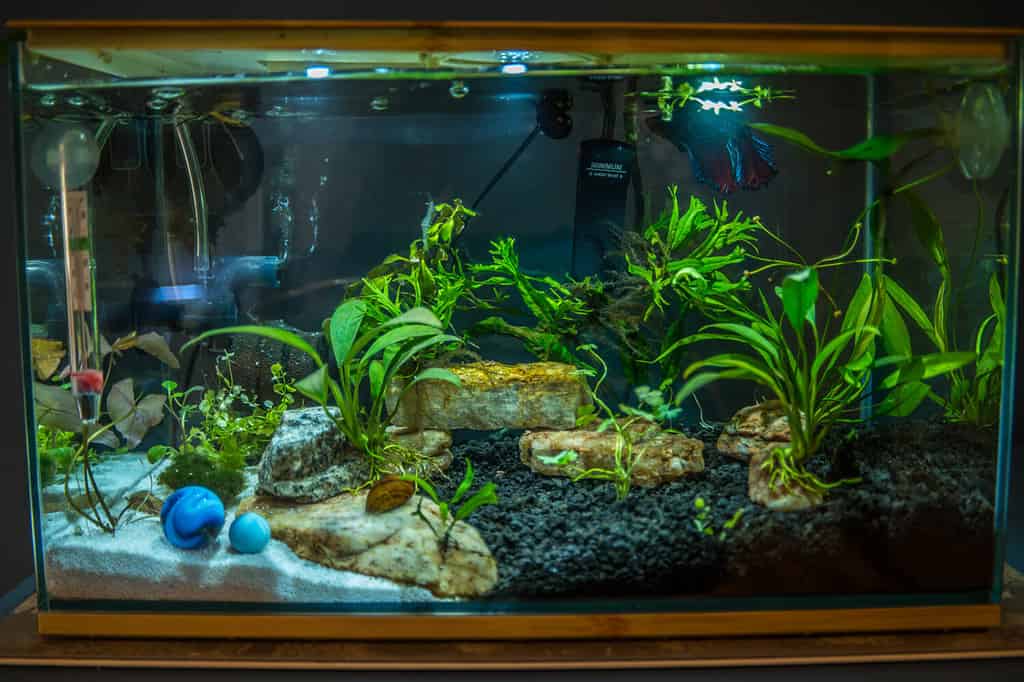
Live plants help improve the aquarium’s water quality by using nitrates for growth.
©Sandra Burm/Shutterstock.com
Summary Of The 12 Best Plants for Betta Fish
| Rank | Aquatic Plants |
|---|---|
| 1 | Hornwort |
| 2 | Amazon sword |
| 3 | Java moss |
| 4 | Water sprite |
| 5 | Anubias |
| 6 | Vallisneria |
| 7 | Amazon frogbit |
| 8 | Java fern |
| 9 | Water wisteria |
| 10 | Ludwigia super red mini |
| 11 | Dwarf hairgrass |
| 12 | Pennywort |
Thank you for reading! Have some feedback for us? Contact the AZ Animals editorial team.








